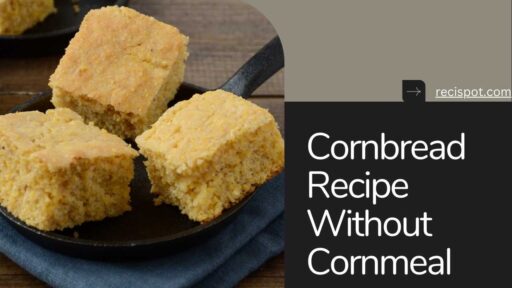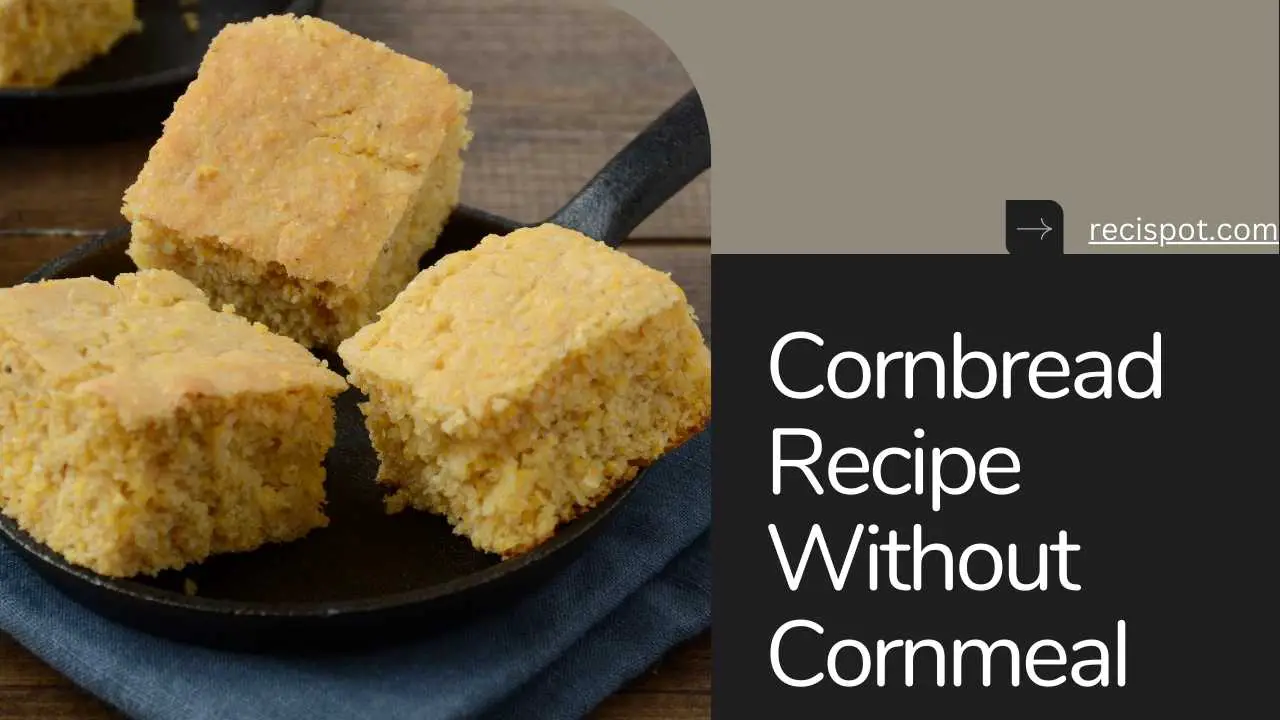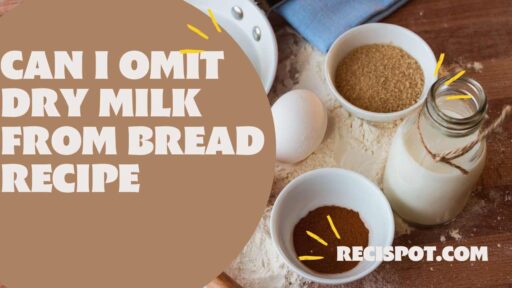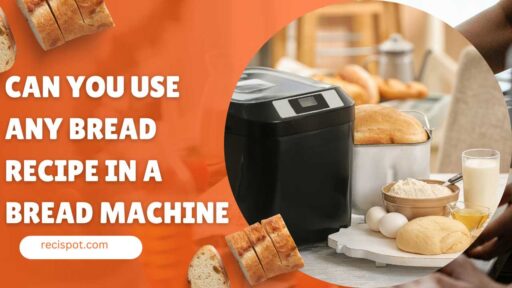Looking for a cornbread recipe without cornmeal? Look no further! Our website provides a delectable option that is sure to impress your taste buds. Try it today!
Think about the warmth of a newly-baked piece of Cornbread Recipe Without Cornmeal, fresh out of the oven and releasing its sweet, golden aroma. One can’t help but feel comforted by this quintessential Southern staple, which is cornbread. However, what if you could have all those delicious charms without using any cornmeal at all? In this article, we will rewrite the story of cornbread by examining alternate flours that not only buck tradition but also put a healthier twist on an old favorite.
The Cornbread Recipe Without Cornmeal Problem
Before we get into alternative flours, let’s address the elephant in the room – why do we need to reinvent cornbread anyway? While it’s true that traditional cornbreads hold special places in many people’s hearts (and stomachs), they can also present some problems. First off, processed grains used as an ingredient, like maize flour, may be hard for certain individuals’ digestive systems to break down easily due to their high processing levels.
Secondly, being allergic or having dietary restrictions against consuming grains such as wheat makes it impossible for them to eat regular bread made from these ingredients without experiencing adverse reactions. Lastly, since conventional recipes tend to be calorie-dense with little nutritional value, they don’t align well with anyone trying to watch their healthful diets.
Flourishing Change
With gluten-free and other alternative diet trends on the rise, there has been an influx of different types of flour available on the market today than ever before. These flours are produced from various grains, nuts, and legumes which give them unique flavor profiles along with nutritional attributes too such as protein content etcetera thus making versatile substitutes for wheat flour in several recipes including cornbreads.
Almond Flour
Almond flour is a popular choice among those seeking alternatives to traditional white or whole wheat flour due its nutty taste that complements many baked goods perfectly well. Besides being packed full of healthy fats, proteins, and fibers, all important nutrients our bodies need more of. It can also be used in combination with other ingredients like eggs and butter for added richness when making Cornbread recipes without Cornmeal.
Coconut Flour
Another alternative flour gaining popularity lately because it is low carb as well as gluten, among other health benefits associated with diets such as paleo etcetera, involves the use of coconut flour, which comes from ground-up dried bits left over after extracting milk oil from coconuts. The resulting product has high fiber content alongside good fats and proteins, too, not to mention its slightly sweet flavor that pairs nicely against cornbread’s sweetness.
Chickpea Flour
Chickpeas are an excellent source of plant-based protein; therefore, their byproduct, known as chickpea or garbanzo bean flour, makes a great addition to any recipe calling for ordinary wheat-based types. This type contains considerably higher amounts of iron and magnesium, among other micronutrients, compared to regular all-purpose flours, so if you want your cornbread recipe healthier without sacrificing taste, then try adding some nutty flavors alongside denser textures by incorporating this ingredient.
Playing With Flours In Corn Bread
Now that we have gone through a few examples, it is time to put them into practice with our own favorite cornbread recipes. Here are tips on how best to use alternate flours while preparing such delicious dishes:
- Start small: When experimenting with different flours in a traditional cornbread recipe, begin by replacing just part of the wheat flour until the desired texture and consistency are achieved.
- Mix it up: Don’t be afraid to mix various combinations thereof to get more complex tasting results at the end while still maintaining heightened nutritional value too!
- Keep moist: Certain types may require additional liquid or wet components compared to what could typically be found within conventional formulations, thus preventing dryness from occurring during the baking process.
Cornbread has been a popular part of Southern cooking for generations. It consists of cornmeal, flour, eggs, and milk, with butter or bacon fat for added richness. But as more and more people adopt gluten-free diets and look for healthier alternatives to wheat flour, cornbread is getting a second look. Can this comfort food be reinvented without losing its soul? Yes.
Healthy Alternative Flours
We don’t have to stick with cornmeal as the base; many other flours can add flavors and nutrients to our bread. Almond flour is a common gluten-free option that has a slightly nutty taste and some extra protein. Buckwheat flour – despite its name – is unrelated to wheat at all but does have an earthy flavor that pairs well with savory dishes; it’s also high in fiber and such minerals as magnesium and manganese. Chickpea flour offers a mild sweetness plus plant-based proteins.
Let Creativity Flow
Alternative flours allow us to play around with various flavor combinations when making our own version of cornbread. For instance, you could substitute regular milk for coconut or almond milk, which not only adds sweetness but is also lactose-free and is suitable for those who are allergic to or intolerant of dairy products. If you want healthier fats without sacrificing taste, then replace butter with avocado oil – this way, your dish will still be rich but much better for your heart!
Another thing worth trying out is adding herbs like thyme, basil, mint, etc., spices such as cumin, paprika, cinnamon, etc., or even grated carrot, zucchini, beetroot, etc. into the mix — trust me, once you try these variations, there’s no going back!
The Outcome
Reimagining cornbread using alternative flours not only provides us with better-for-you options but also allows room for imagination while cooking up something warm and delicious in the kitchen! Whether one has dietary restrictions or just wants to experiment a little bit more, there are countless ways to give this classic dish new life.
So next time when you crave some moistness under the crusty top layer of goodness known as cornbread, consider going off-beat by using different grain-based ingredients such as amaranth or teff flour, among others. Your taste buds, along with your waistline, will thank you for taking such bold steps towards healthy eating habits!
Why A Cornbread Recipe Without Cornmeal?
Before we dive into making cornbread without cornmeal, let’s address the big question—why would anyone want to leave out an essential part? There could be several reasons – it could be that one is allergic to maize or maybe looking forward to reducing their intake of grains in general; alternatively, they might just have run out of cornmeal and still feel like having some good old-fashioned Southern comfort food. Well, whichever way you look at it, rest assured our alternative flour approach not only fills up this gap but also provides a better way of making the much-loved dish. Cooking should always be about venturing beyond what has been done before;
therefore, through experimenting with different components, we can not only challenge established norms but also widen our cooking skills base, which ultimately leads us onto exciting new paths filled with tasteful delights! So do not be afraid to break away from tradition and try something unique today – who knows? This may just turn out to be another favorite recipe amongst many others in your collection.
Discovering Your Choices
Once you get rid of cornmeal, you’ll find yourself face-to-face with a variety of alternative flours, each with its unique benefits and flavors.
- Almond Flour: Almond flour is like the gluten-free community’s darling; it adds a moist crumb to your cornbread that is light and slightly nutty.
- Oats: Ground oats have a more robust quality that gives your cornbread a dense yet rustic texture.
- Wheat Flour: For those who are not gluten-sensitive, wheat flour can mimic the texture and taste of cornbread, giving you a closer experience to the classic one.
No-Cornmeal Cornbread Recipe
Here is a simple recipe using alternative flours to create a no-cornmeal cornbread that is easy to make and delicious.
Ingredients
1 cup of any flour (almond, oats, wheat, or mix)
1 tbsp baking powder
1/2 tsp salt
Two large eggs
1/3 cup sweetener (honey/maple syrup/sugar, depending on preference)
1 cup milk (dairy/non-dairy)
1/4 cup melted butter or oil
Instructions
- Preheat oven to 400°F (200°C) and lightly grease an 8-inch square baking dish.
- Whisk together the flour(s) of your choice, baking powder, and salt in a mixing bowl.
- Beat eggs in another bowl, then stir in sweetener choice, milk, and melted butter.
- Combine wet ingredients with dry just until incorporated – overmixing will result in tougher breads!
- Pour batter into prepared baking dish; bake for 20-25 minutes until edges are golden browned & toothpick inserted into the center comes out clean.
- Allow cornbread to cool for a few minutes before slicing & serving.
The Health Advocate’s Cornbread
Swapping out cornmeal for other flours, such as oats or almonds, doesn’t just take you down another culinary path—it leads to a healthier destination.
- Almond Flour’s Assets: Almond flour is packed with healthy fats, protein, and fiber. It’s also an excellent source of vitamin E and magnesium.
- Oat Flour’s Advantages: Oats add more fiber to the mix, which promotes good digestion and keeps you fuller for longer.
- Wheat Flour’s Warnings: Wheat flour may be the most common alternative, but it isn’t the healthiest one because apart from containing gluten, almond or oat flour is more nutritious than wheat.
Serving Suggestions That Satisfy
Now that your cornbread has been redefined, it needs a suitable partner. Here are some serving suggestions that will pair well with the unique flavors and textures of your no-cornmeal cornbread:
Savory Pairings: Fresh and savory stews like chili or hearty vegetable soup
Spread with butter or your favorite nut butter for a quick snack
Topped with avocado, poached eggs & a sprinkle of chili flakes for a healthy breakfast/brunch
Sweet Combos: A generous drizzle of honey or maple syrup
Fruity jams/warm fruit compote as a sweet ending to the meal
Dollop whipped cream/fresh berries for a delightful dessert upgrade
Sharing is caring, especially in baking. We want to hear from you! Share your knowledge of using different flours for cornbread, post the fun ways you’ve tweaked the recipe, or engage with other readers in the comments below.
Frequently Asked Questions (FAQs)
Can I use coconut flour instead?
Yes, but take note that coconut flour is highly absorbent, so you may need to adjust the liquid ingredients in the recipe until you achieve the desired consistency.
Is there a vegan version of this cornbread recipe?
Certainly! To make a vegan version, substitute eggs with flaxseed or chia seeds mixture (1 tablespoon ground flaxseed or chia seeds mixed with three tablespoons water equals one egg) and use plant-based milk and butter alternatives.
How long will this cornbread stay fresh?
Keep this cornbread in an airtight container at room temperature for up to 2 days or refrigerate for a week. For longer storage, freeze it for up to 3 months.
Can I add corn kernels even though it’s no-cornmeal cornbread?
Yes, adding corn kernels will bring out more flavor and texture. It’s a great way to get some of that traditional cornbread feel without using cornmeal.
What if I don’t have an 8-inch square baking dish?
Not a problem! You can use any pan or baking dish of a similar size. Just note that the thickness of your cornbread may vary slightly, which could also affect baking time.
How do I keep my cornbread moist and prevent it from becoming dry?
Do not overmix the batter as this will allow the gluten in the flour to develop thus resulting in drier/tougher bread. Also, ensure accurate measurement especially for liquids so as not to mess with moisture content.
Conclusion of Cornbread Recipe Without Cornmeal
Cornbread Recipe Without Cornmeal represents more than just another side dish; it reflects culture itself and is an embodiment of life’s simple pleasures. In light of alternative flours, we have opened up a creative space while remaining true to the comforting nature of cornbread. Try out this recipe and see how many flavors, textures, and possibilities you can discover. Just a slight twist on an old favorite can yield huge, delicious results!






